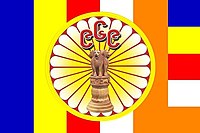
Back حركة 969 Arabic ৯৬৯ আন্দোলন Bengali/Bangla Movimiento 969 Spanish Mouvement 969 French 969 (תנועה) HE Gerakan 969 ID 969運動 Japanese ၉၆၉ လှုပ်ရှားမှု Burmese 969 ਤਹਿਰੀਕ Punjabi Ruch 969 Polish
| 969 Movement | |
|---|---|
| ၉၆၉ လှုပ်ရှားမှု | |
 | |
| Founder | Ashin Wirathu |
| Country | Myanmar |
| Ideology | Islamophobia Religious nationalism |
The 969 Movement (Burmese: ၉၆၉ လှုပ်ရှားမှု) is a Buddhist nationalist movement[1] opposed to what they see as Islam's expansion in predominantly Buddhist Myanmar (Burma).[2][3] The three digits of 969 "symbolize the virtues of the Buddha, Buddhist practices and the Buddhist community".[1][2][4] The first 9 stands for the nine special attributes of the Buddha and the 6 for the six special attributes of his Dharma, or Buddhist Teachings, and the last 9 represents the nine special attributes of Buddhist Sangha (monastic community). Those special attributes are the Three Jewels of the Buddha. In the past, the Buddha, Sangha, Dhamma, the wheel of Dhamma, and "969" were Buddhist signs.[5]
The movement has had strong reactions within[6] and beyond Myanmar. In the international media it has received criticism. The Straits Times reported that Ashin Wirathu, the movement's leader, responded to recent anti-Muslim violence with pledges to work for peace, but critics remain sceptical.[7]
Various media organizations have described the movement as being anti-Muslim or "Islamophobic".[8][9][10][11] The movement's Myanmar Buddhist supporters deny it is anti-Muslim, with Bhikkhu Wirathu stating it is a protective movement about targeting "Bengalis who are terrorizing ethnic Rakhine (Buddhists)".[12] Alex Bookbinder, in The Atlantic, links the movement's origins in a book written in the late 1990s by Kyaw Lwin, a functionary in the Ministry of Religious Affairs, and its precepts are rooted in a traditional belief in numerology. Across South Asia, Muslims represent the phrase "In the Name of God, the Compassionate and Merciful" with the number 786, and businesses display the number to indicate that they are Muslim-owned. 969's proponents see this as a Muslim plot to conquer Burma in the 21st century, based on the premise that 7 plus 8 plus 6 is equal to 21. The number 969 is intended to be 786's cosmological opposite.[1]
- ^ a b c "969: The Strange Numerological Basis for Burma's Religious Violence - Alex Bookbinder". The Atlantic. 9 April 2013. Retrieved 19 October 2013.
- ^ a b Cite error: The named reference
NYTviaSwas invoked but never defined (see the help page). - ^ Cite error: The named reference
at20130402was invoked but never defined (see the help page). - ^ Cite error: The named reference
irr30965was invoked but never defined (see the help page). - ^ "Nationalist Monk U Wirathu Denies Role in Anti-Muslim Unrest". Irrawaddy.org. 2 April 2013. Retrieved 19 October 2013.
- ^ "Monks speak out against misuse of '969'". Mmtimes.com. 10 April 2013. Retrieved 19 October 2013.
- ^ Nirmal Ghosh (1 April 2013). "Anti-Muslim monk changes tack, vows to promote peace". The Straits Times.
- ^ Downs, Ray (27 March 2013). "Is Burma's Anti-Muslim Violence Led by Buddhist Neo-Nazis ?". Vice.com. Retrieved 19 October 2013.
- ^ Sardina, Carlos (10 May 2013). "Who are the monks behind Burma's '969' campaign? | DVB Multimedia Group". Dvb.no. Archived from the original on 31 October 2013. Retrieved 19 October 2013.
- ^ Lindsay Murdoch (15 April 2013). "Anti-Muslim movement hits Myanmar". Sydney Morning Herald. Retrieved 19 October 2013.
- ^ "Myanmar's extremist Buddhists get free rein". Nation.com.pk. Archived from the original on 15 October 2013. Retrieved 19 October 2013.
- ^ "Religious radicals driving "Myanmar's" unrest". Global Post. 31 March 2013. Archived from the original on 24 December 2018. Retrieved 21 April 2013.